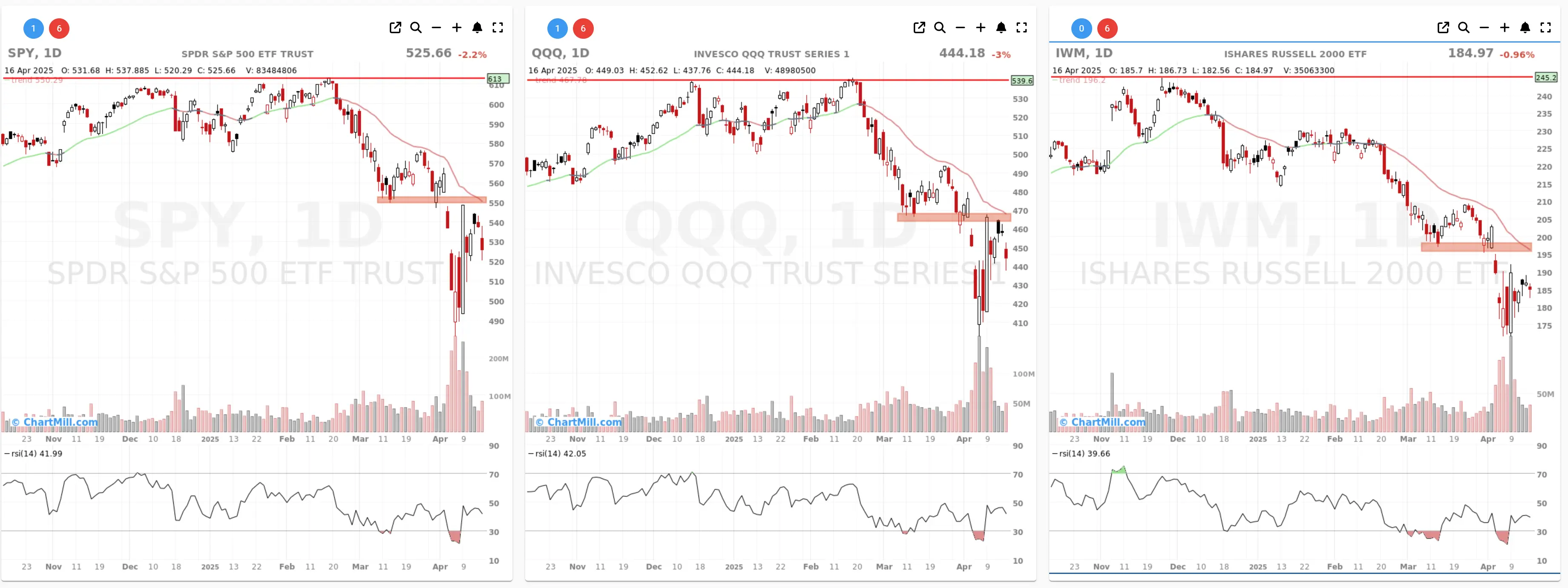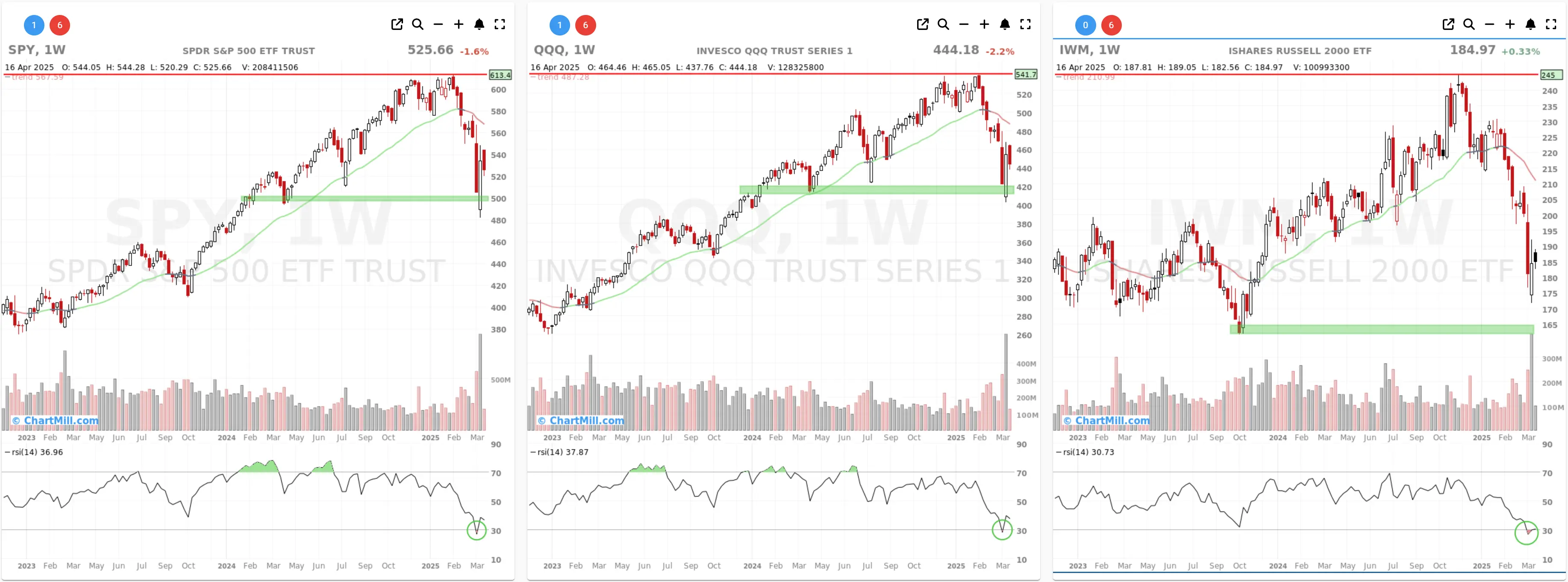Market Monitor April 17 ( Hertz UP, Nvidia, AMD DOWN)
By Kristoff De Turck - reviewed by Aldwin Keppens
Last update: Apr 17, 2025

Wall Street Tumbles as Powell Dashes Rate-Cut Hopes, Nvidia Sinks on Export Restrictions
U.S. stocks fell sharply Wednesday after Federal Reserve Chairman Jerome Powell dampened expectations for interest rate cuts, warning that trade tensions could complicate the Fed’s fight against inflation.
The Nasdaq tumbled over 3%, while the Dow Jones dropped 1.75%, as solid retail sales data failed to offset significant losses in the technology sector.
Tech stocks were hit particularly hard after Nvidia (NVDA | -6.9%) issued a profit warning, taking a $5.5 billion charge due to stricter U.S. export restrictions on its H20 chips to China. Nvidia shares plunged 7%, dragging down competitors like AMD (AMD |-7.3%), which also fell 7% following its own $800 million provision tied to similar restrictions.
Other chipmakers such as Broadcom (AVGO | -2.4%) and Micron (MU | -2.4%) fell over 2%.
Despite better-than-expected retail sales - which rose 1.4% month-over-month and 4.6% year-over-year, driven by preemptive consumer purchases ahead of new tariffs - investors remained uneasy.
Powell emphasized that the Fed is committed to anchoring inflation expectations and hinted that the central bank would not step in with rate cuts to counter economic disruptions caused by tariffs.
Outside tech, shares of Hertz (HTZ | +56.4%) soared 56% after investor Bill Ackman’s Pershing Square disclosed a substantial stake, while Alphabet (GOOG | -2.0%) fell nearly 2% amid a major class-action lawsuit in the UK over alleged abuse of market dominance.
Investors will closely watch Thursday's economic data, including weekly jobless claims, housing starts, and the Philadelphia Fed index, for further clues on the economy’s health.
Daily Market Analysis – April 16, 2025 (After Market Close)
Short Term Trend

- Short-Term Trend: Down (no change)
- Support at $500
- Resistance at $550
- Short-Term Trend: Down (no change)
- Support at $415
- Resistance at $466
- Short-Term Trend: Down (no change)
- Support at $170
- Resistance at $197
Long Term Trend

- Long-Term Trend: Down (no change)
- Long-Term Trend: Down (no change)
- Long-Term Trend: Down (no change)
Market Breadth Analysis for April 16, 2025 (After Market Close)

1. Market Sentiment Shifts Back to Bearish
- April 16 saw 32.3% advancing stocks versus 65.7% declining stocks, indicating a clear bearish tilt.
→ This contrasts sharply with the recent bullish surge (Apr 11–14), and signals that bearish sentiment is resurfacing.
2. Momentum Analysis: Weakness Returns
-
Advancing Stocks +4%: Only 2.9%.
-
Declining Stocks -4%: Increased significantly to 4.5%, the highest since April 8.
→ This indicates renewed selling pressure and weakening momentum in market breadth.
3. Internals Remain Weak
Stocks Above Key Moving Averages remain historically low, showing very weak internal health:
-
Above SMA(20): 20.4%
-
Above SMA(50): 15.7%
-
Above SMA(100): 17.1%
-
Above SMA(200): 19%
→ This remains below healthy levels, signaling continued broader market weakness.
4. Weekly, Monthly, and Quarterly Trends
Weekly Breadth shifted sharply bearish again, now 37.7% advancing vs. 61.5% declining. A quick reversal from prior week's strength (87.3% advancing).
Monthly & Quarterly Breadth remain deeply negative:
-
Monthly: Only 13.7% advancing vs. 86% declining.
-
3-Month: Just 21.8% advancing, with 77.4% declining.
-
Significant underperformance in stocks that lost >25% over 3 months (22.6% vs only 3.7% gaining similarly).
Conclusion & Outlook
The market breadth data highlights a rapid shift back to bearish sentiment following recent short-lived bullish strength. Underlying market health remains poor, with a small percentage of stocks above their moving averages and consistently weak long-term breadth.
This suggests caution going forward, as the market remains vulnerable to further declines without sustained improvement in internal strength.
5.71
+2.06 (+56.44%)
155.5
-3.18 (-2%)
88.29
-7 (-7.35%)
104.49
-7.71 (-6.87%)
69.33
-1.71 (-2.41%)
174.61
-4.34 (-2.43%)
Find more stocks in the Stock Screener
HTZ Latest News and Analysis
 2 hours ago - ChartmillMarket Monitor April 17 ( Hertz UP, Nvidia, AMD DOWN)
2 hours ago - ChartmillMarket Monitor April 17 ( Hertz UP, Nvidia, AMD DOWN)Wall Street Tumbles as Powell Dashes Rate-Cut Hopes, Nvidia Sinks on Export Restrictions
 20 hours ago - ChartmillWhat's going on in today's pre-market session
20 hours ago - ChartmillWhat's going on in today's pre-market sessionThe US market session of Wednesday has yet to be opened, let's have a look at the top gainers and losers in the pre-market session today.


